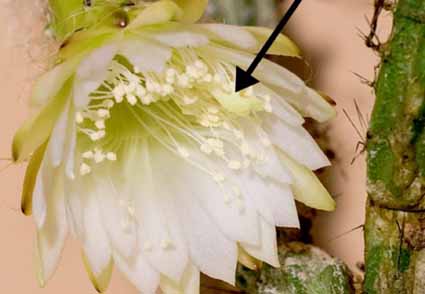Abstract
Deamia funis sp. nov. (Cactaceae) from Nicaragua, in the Mesoamerican region, is described and illustrated based on morphological data. The new species is characterized by its often long, dangling (ropey), and relatively narrow, multiribbed stems with relatively small flowers like those of D. chontalensis, but with the stigma exerted among or slightly beyond the anthers as occurs in D. montalvoae and D. testudo.
References
<p align="justify"><span style="color: #000000;"><span style="font-family: Times New Roman, serif;"><span style="font-size: small;">Alexander, E.J. (1950) A new <em>Nyctocereus </em>from southern Mexico. <em>Cactus and Succulent Journal (Los Angeles) </em>22: 131–133.</span></span></span></p>
<p align="justify"><span style="color: #000000;"><span style="font-family: Times New Roman, serif;"><span style="font-size: small;">Bravo-Hollis, H. (1978) <em>Las cactaceas de Mexico. 2nd ed.</em>, vol. 1. Universidad Nacional Autonoma de Mexico, Mexico City, 743 pp. </span></span></span></p>
<p align="justify"><span style="color: #000000;"><span style="font-family: Times New Roman, serif;"><span style="font-size: small;">Britton, N.L. & Rose, J.N. (1920) <em>The Cactaceae. Descriptions and illustrations of plants of the cactus family</em>, vol. 2. Carnegie Institute, Washington, 248 pp. https://doi.org/10.5962/bhl.title.46288</span></span></span></p>
<p align="justify"><span style="color: #000000;"><span style="font-family: Times New Roman, serif;"><span style="font-size: small;">Cerén, G., Cruz, M.A., Menjívar, J. & Arias, S. (2018) A new species of <em>Deamia</em> (Cactaceae) from the Mesoamerican region. <em>Phytotaxa</em> 369: 251–259. https://doi.org/10.11646/phytotaxa.369.4.2</span></span></span></p>
<p align="justify"><span style="color: #000000;"><span style="font-family: Times New Roman, serif;"><span style="font-size: small;">Doweld, A.B. (2002 ‘2001’) Re-classification of Rhipsalideae, a polyphyletic tribe of the Cactaceae. <em>Sukkulenty </em>1–2: 25–45. </span></span></span></p>
<p align="justify"><span style="color: #000000;"><span style="font-family: Times New Roman, serif;"><span style="font-size: small;">IUCN Standards and Petitions Committee. (2022) Guidelines for Using the IUCN Red List Categories and Criteria. Version 15.1. Prepared by the Standards and Petitions. [https://www.iucnredlist.org/documents/RedListGuidelines.pdf]</span></span></span></p>
<p align="justify"><span style="color: #000000;"><span style="font-family: Times New Roman, serif;"><span style="font-size: small;">Korotkova, N., Borsch, T. & Arias, S. (2017) A phylogenetic framework for the Hylocereeae (Cactaceae) and implications for the circumscription of the genera. <em>Phytotaxa </em>327: 1–46. https://doi.org/10.11646/phytotaxa.327.1.1</span></span></span></p>
<p align="justify"><span style="color: #000000;"><span style="font-family: Times New Roman, serif;"><span style="font-size: small;">Mandujano, M.d.C., Carrillo-Angeles, I., Martínez-Peralta, C. & Golubov, J. (2010) Reproductive biology of Cactaceae. <em>In</em>: Ramawat, K. (Ed.) <em>Desert plants: biology and biotechnology</em>. Springer, Berlin, Heidelberg, pp. 197–230. https://doi.org/10.1007/978-3-642-02550-1_10</span></span></span></p>
<p align="justify"><span style="color: #000000;"><span style="font-family: Times New Roman, serif;"><span style="font-size: small;">Zuccarini, J.G. (1837) Plantarum novarum vel minus cognitarum, quae in horto botanico herbarioque regio monacensi servantur, fasciculus tertiuis. Cacteae. <em>Abhandlungen der Mathematisch-Physikalischen Klasse der Königlich Bayerischen Akademie der Wissenschaften </em>2: 601–742. </span></span></span></p>
<p align="justify"><span style="color: #000000;"><span style="font-family: Times New Roman, serif;"><span style="font-size: small;">Bravo-Hollis, H. (1978) <em>Las cactaceas de Mexico. 2nd ed.</em>, vol. 1. Universidad Nacional Autonoma de Mexico, Mexico City, 743 pp. </span></span></span></p>
<p align="justify"><span style="color: #000000;"><span style="font-family: Times New Roman, serif;"><span style="font-size: small;">Britton, N.L. & Rose, J.N. (1920) <em>The Cactaceae. Descriptions and illustrations of plants of the cactus family</em>, vol. 2. Carnegie Institute, Washington, 248 pp. https://doi.org/10.5962/bhl.title.46288</span></span></span></p>
<p align="justify"><span style="color: #000000;"><span style="font-family: Times New Roman, serif;"><span style="font-size: small;">Cerén, G., Cruz, M.A., Menjívar, J. & Arias, S. (2018) A new species of <em>Deamia</em> (Cactaceae) from the Mesoamerican region. <em>Phytotaxa</em> 369: 251–259. https://doi.org/10.11646/phytotaxa.369.4.2</span></span></span></p>
<p align="justify"><span style="color: #000000;"><span style="font-family: Times New Roman, serif;"><span style="font-size: small;">Doweld, A.B. (2002 ‘2001’) Re-classification of Rhipsalideae, a polyphyletic tribe of the Cactaceae. <em>Sukkulenty </em>1–2: 25–45. </span></span></span></p>
<p align="justify"><span style="color: #000000;"><span style="font-family: Times New Roman, serif;"><span style="font-size: small;">IUCN Standards and Petitions Committee. (2022) Guidelines for Using the IUCN Red List Categories and Criteria. Version 15.1. Prepared by the Standards and Petitions. [https://www.iucnredlist.org/documents/RedListGuidelines.pdf]</span></span></span></p>
<p align="justify"><span style="color: #000000;"><span style="font-family: Times New Roman, serif;"><span style="font-size: small;">Korotkova, N., Borsch, T. & Arias, S. (2017) A phylogenetic framework for the Hylocereeae (Cactaceae) and implications for the circumscription of the genera. <em>Phytotaxa </em>327: 1–46. https://doi.org/10.11646/phytotaxa.327.1.1</span></span></span></p>
<p align="justify"><span style="color: #000000;"><span style="font-family: Times New Roman, serif;"><span style="font-size: small;">Mandujano, M.d.C., Carrillo-Angeles, I., Martínez-Peralta, C. & Golubov, J. (2010) Reproductive biology of Cactaceae. <em>In</em>: Ramawat, K. (Ed.) <em>Desert plants: biology and biotechnology</em>. Springer, Berlin, Heidelberg, pp. 197–230. https://doi.org/10.1007/978-3-642-02550-1_10</span></span></span></p>
<p align="justify"><span style="color: #000000;"><span style="font-family: Times New Roman, serif;"><span style="font-size: small;">Zuccarini, J.G. (1837) Plantarum novarum vel minus cognitarum, quae in horto botanico herbarioque regio monacensi servantur, fasciculus tertiuis. Cacteae. <em>Abhandlungen der Mathematisch-Physikalischen Klasse der Königlich Bayerischen Akademie der Wissenschaften </em>2: 601–742. </span></span></span></p>


